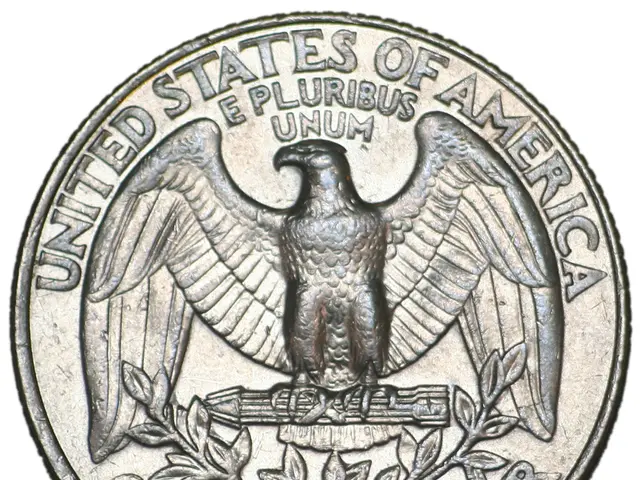Digital authorities vehemently oppose the adoption of digital assets
The US dollar's dominance as the world's primary currency faces growing doubts, with several alternatives emerging in a fragmented global landscape. Experts from various institutions have weighed in on the potential threats to the dollar's supremacy and the challenges these alternatives face.
Yara Aziz, senior economist at OMFIF, discusses the growing doubts about the foundations of dollar dominance. Jens Søndergaard, currency analyst at Capital Group, notes that a weaker dollar amid US policy volatility is creating opportunities for other currencies, but there is no real alternative yet.
One such alternative is the Chinese renminbi (RMB). The RMB benefits from China's large economy, deep financial markets, substantial trade surpluses, and foreign exchange reserves. However, geopolitical tensions, capital controls, limited convertibility, and perceived lack of transparency constrain its broader international role as a neutral reserve currency. The RMB is used in about 50% of intra-BRICS trade but only roughly 2% in global payments overall.
The BRICS bloc (Brazil, Russia, India, China, South Africa) has discussed creating a new blockchain-based currency and cross-border payment systems to challenge dollar dominance. However, practical issues remain unresolved, such as settlement of trade imbalances and the absence of a clearing institution or a mandated vehicle currency.
Digital currencies and CBDCs, such as China’s e-CNY and the European digital euro, could reduce reliance on the dollar by enabling faster and cheaper cross-border payments without dollar intermediaries. However, stablecoins are mostly pegged to the dollar (~99%), reinforcing dollar dominance even in the crypto space.
Despite these alternatives, the US dollar remains dominant. It accounts for approximately 58% of official foreign reserves, is involved in 88% of foreign exchange transactions, and serves as the primary currency in global trade invoicing. Trustworthiness, liquidity, and the lack of a viable, fully stable alternative maintain this dominance despite gradual diversification by some central banks into gold and other currencies.
While multiple alternatives to the US dollar face substantial economic, political, and technical hurdles, the dollar continues to be the most trusted and widely used global currency by a significant margin. The dollar's dominant role is expected to continue well into the medium term.
[1] OMFIF's Global Public Investor series explores the investment strategies of central bank reserve managers, public pension funds, and sovereign funds across the world. [2] Analysts from institutions like the Peterson Institute and Atlantic Council conclude BRICS pose no serious short- to medium-term threat to the dollar’s dominance. [3] OMFIF's Global Public Investor 2025 found that no central bank surveyed holds any digital assets, and 93% have no intention of doing so. [4] Michael Paulus, Alberto Torres, Sunil Kaushik, Natalie Tsui, Tobias Cheung, and Citi note that central banks are turning back to gold as the role of gold is changing. [5] Pierpaolo Benigno and Edoardo Reviglio suggest that Europe has a strategic opportunity to develop its own safe asset.
- Jens Søndergaard, a currency analyst at Capital Group, highlights that US policy volatility is leading to a weaker dollar, presenting opportunities for other currencies, but he acknowledges that no real alternative has emerged as yet.
- Yara Aziz, a senior economist at OMFIF, delves into the growing doubts about the foundations of dollar dominance.
- One such alternative to the US dollar is the Chinese renminbi (RMB), strengthened by China's large economy, deep financial markets, and substantial trade surpluses, yet its broader international role is constrained by geopolitical tensions, capital controls, limited convertibility, and perceived lack of transparency.
- BRICS has proposed creating a new blockchain-based currency and cross-border payment systems to challenge dollar dominance, but practical issues like settlement of trade imbalances and the absence of a clearing institution or mandated vehicle currency remain unresolved.
- Digital currencies and CBDCs, such as China’s e-CNY and the European digital euro, could potentially reduce reliance on the dollar by enabling cheaper, faster cross-border payments, but still, most stablecoins (~99%) are pegged to the dollar, reinforcing its dominance even in the crypto space.
- OMFIF's Global Public Investor 2025 found that no central bank surveyed holds any digital assets, and 93% have no intention of doing so, revealing a reluctance to invest in digital currencies.
- Michael Paulus, Alberto Torres, Sunil Kaushik, Natalie Tsui, Tobias Cheung, and Citi note that central banks are turning back to gold as the role of gold is changing, indicating another area of contention for the US dollar's dominance.





